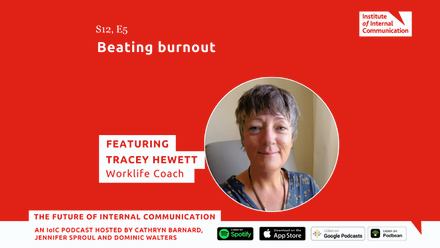This was the question posed by the speakers at the Supporting Staff Wellbeing in the Workplace event. Part of the Diverse Workforce Series, run in partnership with IoIC, the event promised to provide attendees with the tools and strategies to reap the benefits of a healthy, motivated workforce.
Becky Leonard, FutureNet Committee Member, was there to find out what part internal communication can play in supporting a successful wellbeing strategy. Here are her top takeaways:
1. The figures don't lie – wellbeing really matters
While the actual stats are many and varied, they all show one clear result: the impact of poor mental health and wellbeing on our businesses, economy and society is enormous.
For example, did you know that the average number of sick days per year is much higher for mental health issues over physical? Depression averages 19.1 days, compared to health issues caused by obesity (1.2 days) and high sugar (2 days). On top of that, recovering from depression gives you the equivalent of 31 days back!
While the actual stats are many and varied, they all show one clear result: the impact of poor mental health and wellbeing on our businesses, economy and society is enormous.
For example, did you know that the average number of sick days per year is much higher for mental health issues over physical? Depression averages 19.1 days, compared to health issues caused by obesity (1.2 days) and high sugar (2 days). On top of that, recovering from depression gives you the equivalent of 31 days back!
2. If you feel like you're behind on your wellbeing strategy, you're not alone
With only 10 per cent of UK organisations having a standalone wellbeing strategy, and just 17 per cent of these evaluating their impact effectively, each speaker was adamant: it's time organisations took greater responsibility for their employees' wellbeing.
However, don't panic. There are lots of toolkits available to help you make the first step to a successful wellbeing strategy. Examples include mental health charity Mind's employee wellbeing plan and Action for Happiness' 10 Keys to Happier Living.
With only 10 per cent of UK organisations having a standalone wellbeing strategy, and just 17 per cent of these evaluating their impact effectively, each speaker was adamant: it's time organisations took greater responsibility for their employees' wellbeing.
However, don't panic. There are lots of toolkits available to help you make the first step to a successful wellbeing strategy. Examples include mental health charity Mind's employee wellbeing plan and Action for Happiness' 10 Keys to Happier Living.
3. Communications must help to reduce stigma
One in five of us will miss work for stress, however 95 per cent of those people will lie and say it's a because of a physical, not mental, ailment. Now add this to that worrying figure: apparently around half of employees are not interested in company wellbeing schemes.
Arguably this is connected to people's fears that attending wellbeing sessions or speaking out about mental health will make them appear 'weak' in colleagues' eyes. It's internal communication's role to support a cultural change by giving a voice to and supporting those who want to tell their stories, and advocating for services and promoting behaviours.
One in five of us will miss work for stress, however 95 per cent of those people will lie and say it's a because of a physical, not mental, ailment. Now add this to that worrying figure: apparently around half of employees are not interested in company wellbeing schemes.
Arguably this is connected to people's fears that attending wellbeing sessions or speaking out about mental health will make them appear 'weak' in colleagues' eyes. It's internal communication's role to support a cultural change by giving a voice to and supporting those who want to tell their stories, and advocating for services and promoting behaviours.
4. 'Divide and conquer' is not the best wellbeing strategy
Wellbeing must be tackled holistically. Don't divide your strategy into talking about physical, then mental, then financial wellbeing and so on. Repetition is the mother of habit, so we can't be brushing over one theme and then moving onto the next. We need to promote well-rounded, consistent behaviours that support wellbeing for the whole person.
Wellbeing must be tackled holistically. Don't divide your strategy into talking about physical, then mental, then financial wellbeing and so on. Repetition is the mother of habit, so we can't be brushing over one theme and then moving onto the next. We need to promote well-rounded, consistent behaviours that support wellbeing for the whole person.
5. No one function can tackle wellbeing alone, it's everyone's responsibility
One speaker likened human individuality to X-Men. As a group, we may all look like mutants, but actually it's our differences that unite us. We all have our own superpowers and skills. Wellbeing is the gateway to inclusion; it affects absolutely everyone.
One speaker likened human individuality to X-Men. As a group, we may all look like mutants, but actually it's our differences that unite us. We all have our own superpowers and skills. Wellbeing is the gateway to inclusion; it affects absolutely everyone.
So it can't be tackled in isolation by internal communication or HR; it must be everyone's responsibility. After all, gym passes and free fruit are all very well and good, but if you can't get the fundamentals like employee voice, working conditions and pay right, your wellbeing scheme will be at best ornamental, and at worst meaningless.






